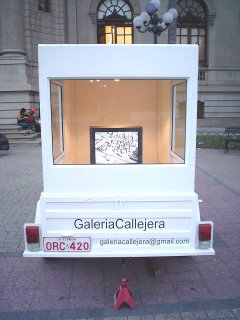GaleriaCallejera , Otras condiciones para el espacio expositivo
 GC GaleriaCallejera, Otras condiciones para el espacio expositivo
GC GaleriaCallejera, Otras condiciones para el espacio expositivoCondicionar la presentación de una producción de obra a un pequeño espacio encajonado es apelar a la innata curiosidad del sujeto.
Un carro de arrastre para automóvil de 500 kilos con elevaciones al modo de caja donde tres de ellos tienen medio cuerpo de ventana, genera un frontis tridimensional como soporte expositivo, así la mirada del espectador ve afectada su posibilidad, lo expuesto solicita su acercamiento y conduce su dirección hacia una diagonal por debajo de su propio horizonte, inclinación que orienta al sujeto a una búsqueda en la profundidad del lugar y a la vez, evidencia un soporte contenedor para aquello que esta ahí. Paralelamente la reducida visual y formas propias del espacio, dejan en evidencia el estado de compresión de la imagen, reforzando la solicitud de un espectador activo.
Esta serie de afecciones llegan a transformar el “mirar” en un husmeo, simulando la experiencia de observar hacia el interior de una habitación a través de una ventana. La mirada está completamente potenciada en su rol de búsqueda, en la acción de indagar, porque está en una posición de esfuerzo. Esta tensión para el espectador fortalece la idea que relaciona el acto de ver arte contemporáneo, a la provocación que acarrea un descubrimiento.
La forma del lugar expositivo, no sólo nos obliga a hacer un esfuerzo para mirar, sino a recorrer lo que es casi imposible recorrer porque existe presentado con cierta retención que articula ocultación, ver significa ingresar al interior efectivo de un lugar, GC conduce la actitud de la mirada hacia la obsesión del fisgón que se reconforta porque ha descubierto cierta cosa que yacía alejada de la visibilidad.
Por otra parte, esta misma minimidad del espacio otorga una existencia única a la obra, sometiéndola a la contención, a un estado de contracción de su expresión, donde la eficacia de la proyección queda asociada a su capacidad de sostener sobre sí la tensión de lo manifiesto. El artista que expone en GC asume el desafío del estado de compresión para sus ideas y sus imágenes, jugando con las asociaciones adjetivas que autoriza el concepto de “opresión”, opresión de volumen, opresión territorial, la opresión misma que deviene del concepto autodenominativo “espacio alternativo”. Opresión que desde éste punto de vista, transfiere el desarrollo de otros conceptos estratégicos para la creación como: estrechez, contención, intensidad, obra cerrada, etc.
GC modifica las condiciones del proceso de producción de obra desnaturalizando el desenvolvimiento para el artista, para la obra y el espectador.
Octubre 2006
Erica Sánchez Doñas
Profesora de Arte
GC GaleriaCallejera , other conditions for the exhibiting space
Conditioning the exhibition of a work production to a small confined space is to appeal to the individual’s natural curiosity
A 500 Kg car trailer with elevations as boxes, where in three of them half of their bodies are windows, creates a three-dimensional front as exhibiting base, affecting the possibility of the spectator’s gaze: what is exposed demands his approaching and leads him to a diagonal line under his own horizon; this slope orientates the individual to a search in the place depth and at the same time, proves to be a containing support for what is there. Parallel to it, the reduced visual line and the characteristic shapes of the space show the compression condition of the picture, reinforcing the demand for an active onlooker.
These varied impressions transform the act of “contemplating” into prying, simulating the experience of watching to the inside of a room through a window. The gaze is entirely strengthened by its searching part, in its inquiring action, because it is in a position of stress. This tension for the spectator reinforces the idea that relates the act of watching contemporary art to the provocation caused by a discovery.
The shape of the exhibiting place, not only forces us to make an effort to look, but also to go through what is almost impossible to go over, because it is there displayed with some retention that formulates concealing, looking means entering the actual interior of a place, GC leads the gaze attitude toward the obsession of the prying who feels comforted because he has discovered something that lied distant from visibility.
On the other hand, this same quality of minimum space gives the work a unique being, submitting it to confinement, to a status of contraction of its expression, where the efficiency of its projection remains associated to its capacity to hold the tension of its revelation. The artist who exhibits in GC assumes the challenge of the state of compression of his ideas and his images, playing with the adjectival associations that the “oppression” concept permits: oppression of size, territorial oppression, the same oppression that comes from the self-denominative concept of “alternative space”. Oppression that from this point of view transfers the development of other concepts strategic to creation such as: tightness, confinement, intensity, enclosed work, etc.
GC modifies the conditions of the production process of the work, denaturalizing the unravelling for the artist, the work and the spectator.
October 2006
Erica Sánchez Doñas
Art Profesor

